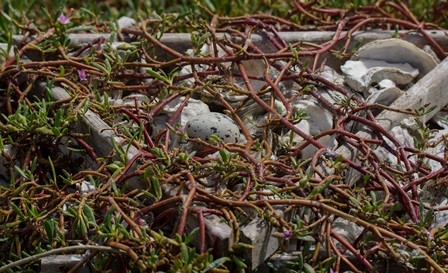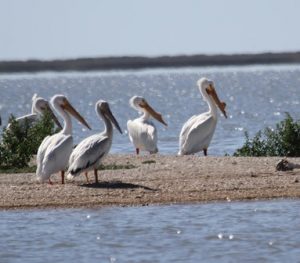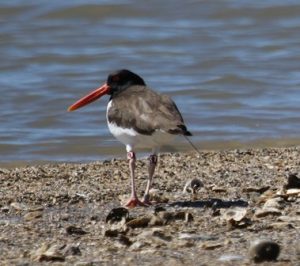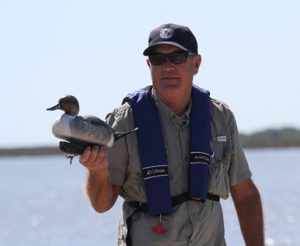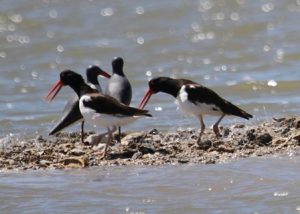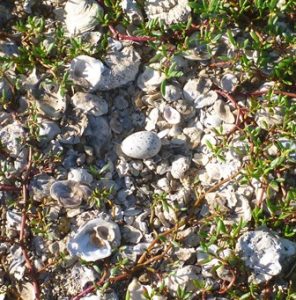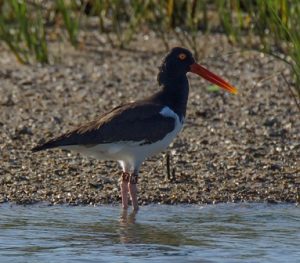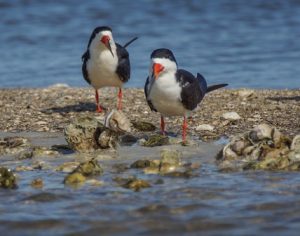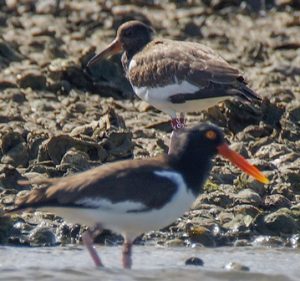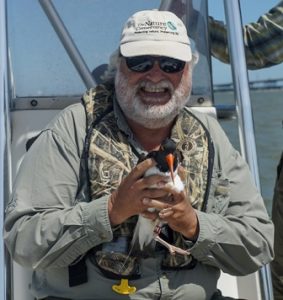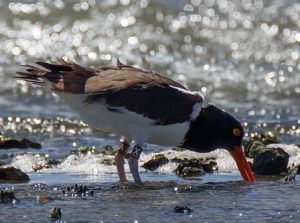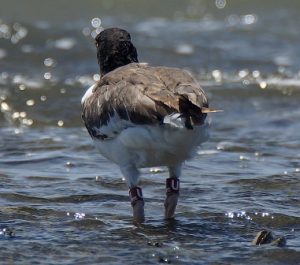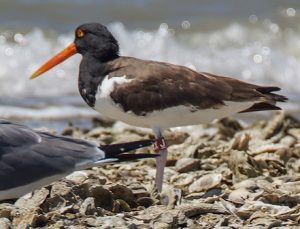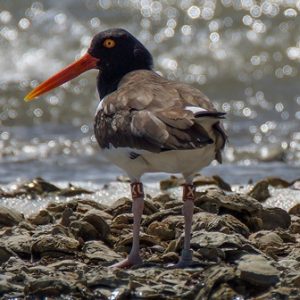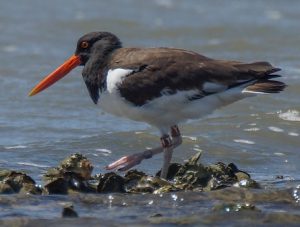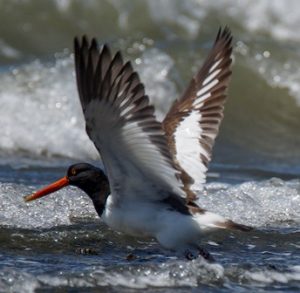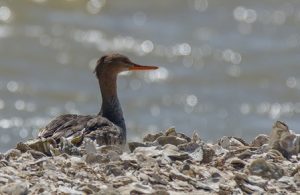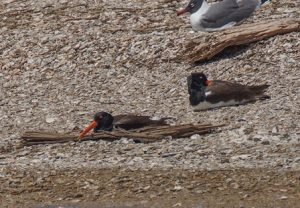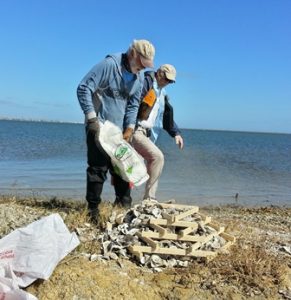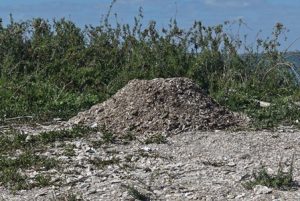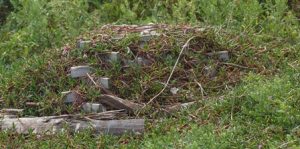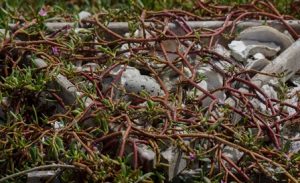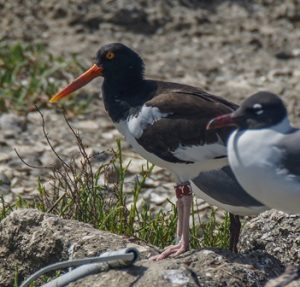By Susan Heath
On Monday I headed out to East Matagorda Bay with Martin Hagne and Oron Atkins. It was really calm for a change and beautiful on the bay. Unfortunately that was not to last but we enjoyed it while it did! We found ER incubating his nest. KN & unbanded, the pair we used the noose carpets on last week were feeding along the GIWW so I guess they haven’t gotten the nesting bug yet. YC was laying down very much like he was on a nest but we found no eggs when we went to check. That pair has faked us out several times this year. We went by Dressing Point and found it much the same as last week. There were lots of American White Pelicans there and many were sporting their breeding bumps.
Nobody really knows why they get these bumps but it seems to be an indication that they are ready for breeding because they only get them in spring and shed them by the end of the breeding season. We checked out the birds at the Oyster Farm on the Gulf side of the bay. KT & unbanded’s nest must have overwashed because it was gone and there was a big washed out place where it was. Bummer. That is their second nest. I’m sure they will try again but what a lot of work they are having to put into this breeding thing. I checked out KT’s nanotag with the handheld receiver and found it was still transmitting.
KM & unbanded had a new nest with two eggs. We tried to trap the unbanded bird in the box but they were having none of it so we gave up. One of the benefits of being out on the bay is all the great stuff you find out there. Mostly we bring back milk crates because they are so useful but today Oron retrieved this really nice Northern Pintail decoy.
We briefly discussed putting it in the wetland at GCBO but decided against it and Oron took it home to add to his collection. There was an unbanded pair of oystercatchers on a tiny shell island in that area so we set up the noose carpets. The island was tiny and since they had no place to go, they stood about 30 feet from us watching the whole time we set up the carpets. When we set up the decoys and I started the MP3 player with the call, we barely had enough time to get the boat away before they were on the decoys. I started snapping some photos.
One of them got caught almost immediately so I headed the boat back over there but before we could get there the other one got caught too! We’ve only caught both birds at once in the noose carpet at once before. The majority of the time, one gets caught and the other one sees what’s up and walks away. I guess because they didn’t have much room, they were extra defensive. Anyway, we banded them LA (female) and LC (male) and let them go. Poor birds. They will never be successful on that tiny island but they will keep trying.
We headed over to Old Gulf Cut and we found 17 guarding his two chicks. I wasn’t able to get a photo of them but they are getting big!
I won’t be out next week to check on them because I’m going to TNC’s Independence Creek Preserve next week with some of our fantastic Experience Auction winners so in two weeks when I’m back out they will be ready to be banded.
Just like last week, we had to move our regular Wednesday survey in West Galveston Bay to Tuesday because of weather. It started out calm but that didn’t last long. We checked on R3 & unbanded near the Tiki Island boat ramp and found their nest had overwashed. John and Alan said there had been some pretty high tides recently so I guess that’s what did it in. We headed up to Swan Lake and found that YK was foraging north of the shell pad he had been defending all season. We haven’t seen YA recently, the bird he was paired with. I heard from my volunteers monitoring the Texas City Prairie Preserve that she was up there and apparently paired with one of their males. I guess she wasn’t happy with the shell pad! Along the Galveston Bay shoreline we found both pairs of birds had new nests with one egg each.
In Swan Lake proper, everything was the same as last week. K7 & unbanded are still keeping their chicks hidden in the spartina. There are a lot of gulls there so that’s the best strategy for them. One of these days the chicks will be big enough to come out and let us see.
R5 & X3 were incubating their nest and the other pairs were hanging out foraging or roosting. Back down in West Galveston Bay, we checked on all the chicks on Struve Luci. The skimmers are back.
The oystercatchers are having some issues though. First, L8 & L9 were not incubating their nest. It was a few days early for it to hatch but I was suspicious because we didn’t see them anywhere. If the nest had failed, they should have been loafing or feeding on the reef. 12 & unbanded were sleeping on their reef and there was no chick with them. That’s the one that surprised us last week with its presence so I’m cautiously optimistic that it’s still alive. I’m not letting them fake me out again! HM & unbanded were both out on their reef which is not good because their reef is not connected to their nesting territory and one of them should have been with their chicks. I have no idea what happened to them. They were getting pretty big. What a bummer!
K6 & JA were there with both their chicks which are getting really big. I’m sure they can fly now but we haven’t seen them do that yet.
We decided to circle the island again to see if we could learn more about the missing chicks. This time L9 was out feeding on the reef and so I wondered if the other one was up in the vegetation hiding with chicks. Time will tell. We didn’t learn anything new about the missing chicks so we moved on. On Jigsaw, one of T5 & T6 was out on a reef and the other one was up in the vegetation so I guess they still have a chick. YE & unbanded had a new nest with two eggs and WW & unbanded were still incubating. The unbanded bird was incubating so I set up the box. We caught the bird in 7 minutes. I love it when a plan comes together! I banded it LH and put a nanotag on it. That island is in a really good spot for the tag to be picked up by several different Motus antennas.
We went to check on 15 & 16, the pair that nests on Galveston Island east of Sportsman Road. They weren’t incubating so I thought the nest had hatched. I went to see if they were hiding behind the berm with chicks and discovered there were still three eggs in the nest. I didn’t see them anywhere but I left quickly so they would hopefully come back. That nest is due to hatch any day now. After checking on the birds at Gangs Bayou, we had to traverse Confederate Reef to get to South Deer Island. I noticed a couple of oystercatchers there so we went to check for bands. We ended up finding six banded birds! Most of them were non-breeders because they are too young or they haven’t found a free territory.
XA was the chick of 12 & unbanded and was banded in April 2013 on Struve Luci Island in West Galveston Bay.
LU was the chick of an unbanded pair and was banded in July 2016 on Jigsaw Island in West Galveston Bay.
JX was the chick of an unbanded pair and was banded in May 2015 on South Deer Island in West Galveston Bay.
XU was the chick of 12 & unbanded and was banded in April 2014 on Struve Luci Island in West Galveston Bay.
YH was the chick of P8 & unbanded and was banded in June 2014 at the Texas City Prairie Preserve.
CE was banded as an adult in March 2016 on South Deer Island in West Galveston Bay. He has not been on the territory where he was banded for some time so we don’t know where he is breeding now.
On South Deer KK & unbanded sleeping down by the water’s edge so something must have happened to their nest. Everybody else there was incubating and we found 13 & unbanded finally decided to lay some eggs, three of them in fact. We headed over to North Deer and Marker 52 and checked on J6 &UF on the way. We discovered a female Red-breasted Merganser sitting where the nest had been, looking for all the world like it was incubating the eggs. We wondered if J6 and/or UF had co-opted out their incubation duties!
The oystercatchers were down by the water’s edge and we didn’t see any chicks so we figured their nest got over washed. Everybody else in that area was incubating except 23 & WY. They were sleeping down by the water’s edge and one of them was cuddled up to a log. I thought maybe they had some chicks snuggled up there too but we didn’t see any when they stood up. I’m still holding out hope though.
The most exciting moment of the day happened when we checked to see what CA & unbanded were up to. We discovered they had a one egg nest which is nice but the exciting thing was that the nest was placed in one of the “oystercatcher condos” that the Galveston Bay Area Master Naturalists built. These condos consist of a wooden frame in the shape of a pyramid. The frame is placed on the island then filled with shell. They built several of them and this is the only one that survived. You can see from the photos that the vegetation has grown around it and it’s become part of the substrate.
We were all very excited about this development. I’m sure CA & unbanded did not know what to make of our high fiving their nest though! Nearby we found another young bird hanging out on the Tiki Spoil.
YY was J6 & P4’s chick and was banded in April 2015 in West Galveston Bay
Another great day with the oystercatchers!
We’ve had a great response to the Adopt-an-Oystercatcher program! Thank you to everyone who has adopted a pair of birds. I will be sending out updates at the end of every month and sometimes in between if something exciting happens with the pair you adopted. If you aren’t familiar with the program – you can adopt a pair of oystercatchers for a $100 donation and I will update you monthly on their progress throughout the breeding season.
Current Stats for upper Texas coast from Dickinson Bay to East Matagorda Bay: 21 nests being incubated, 12 failed nests, 3 nests with unfledged chicks, 3 nests with undetermined status, 2 chicks fledged
This project is supported by the National Fish and Wildlife Foundation and several private donors. If you would like to contribute you can do so by clicking on the Donate Now button below. All donations are tax deductible and GREATLY appreciated.

